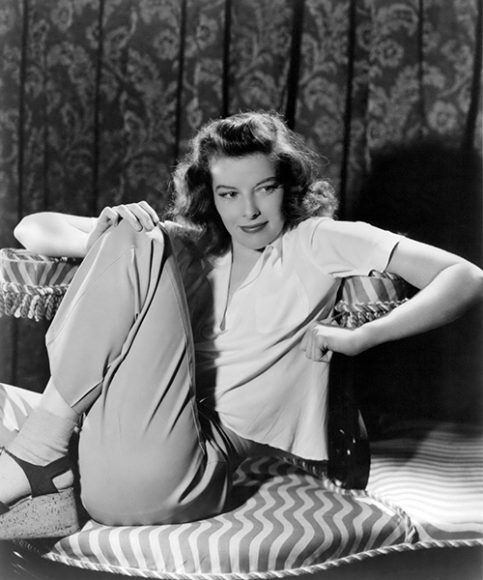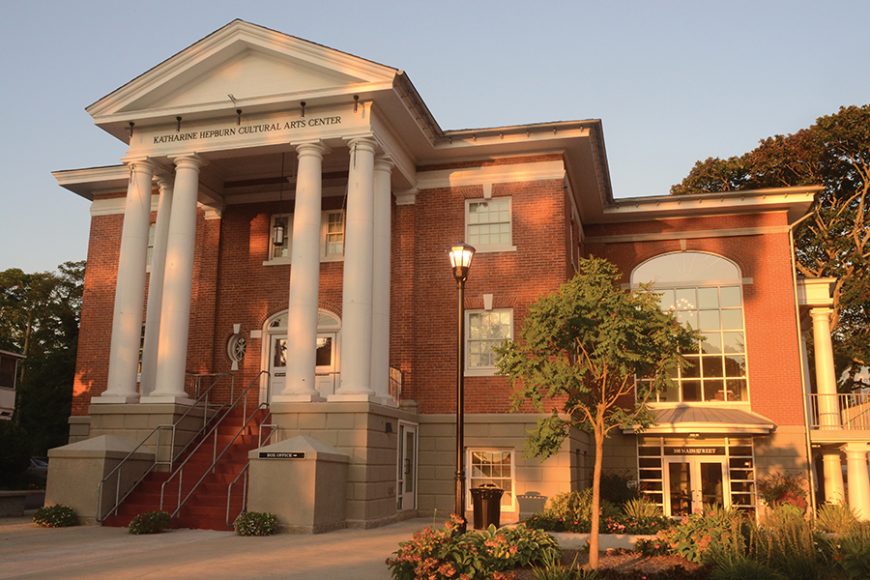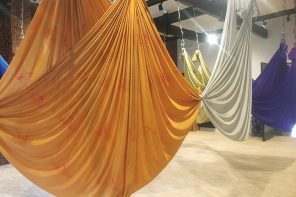While the Connecticut town of Old Saybrook has been home to many acclaimed women, it’s fair to say none is more famous than Katharine Hepburn.
Her name graces a pretty top-floor room with water views at Three Stories, Saybrook Point Inn Marina & Spa’s picturesque, pink property, which is dedicated to the town’s accomplished daughters. And Paradise, her former 8,400-square-foot home in the town’s historic Fenwick community, is in the news once more, on the market.
But perhaps nowhere is her presence more strongly felt than at The Kate, as The Katharine Hepburn Cultural Arts Center on Main Street is lovingly called. The center, an imposing, colonnaded brick structure with a modern addition, has a small but choice museum with a permanent display on the actress and a 250-seat theater. It boasts 33,000 attendees a year for 232 performances that include live music, dance and comedy as well as films, especially Hepburn’s, and simulcasts of the Bolshoi Ballet, The Metropolitan Opera and the National Theatre.
“We have the blessing of Hepburn’s estate,” says Brett Elliott, the center’s executive director, including for “The Kate” — a performance series produced by Connecticut Public Television that has gone national.
That blessing is no small thing. Hepburn (1907-2003) was a formidable woman who did not suffer fools gladly or give herself lightly. Making her first appearance at the Academy Awards in her golden years — she holds the record for most Best Actor trophies with four — she said it took her years to learn to be unselfish. Her Paradise estate contained a sign that read “Go Away,” says John Lombardo, general manager of the Saybrook Point Inn Marina & Spa. He remembers when Hepburn came over to the marina for a reunion with the steamboat The African Queen, which appeared with her and Humphrey Bogart in the 1951 movie of the same title. “She was to the point,” Lombardo says.
He likes to tell the story of two contractors who went over to her house. Hepburn offered them a drink. One asked for bourbon and the other for a glass of white wine. “‘Oh, for God’s sake,’ Hepburn said to the oenophile, ‘Have a real drink.’ That tells you what she was like,” Lombardo says.
“If you obey all the rules, you miss all the fun,” she once said. Feisty and forthright, Hepburn learned to color outside the lines in a progressive family headed by urologist Thomas Norval Hepburn and his wife, the former Katharine Martha Houghton, a suffragist and birth control advocate. Their daughter, the second child and eldest girl in a brood of six, tasted early success after a rocky theatrical start — and early failure. In the 1930s, she was labeled “box office poison” despite a breakout performance in “A Bill of Divorcement” and star turns in what are now classics — including the savvy “Stage Door” with Ginger Rogers and the uproarious “Bringing Up Baby” with Cary Grant — that tapped into her unusual dramatic gifts and a persona that mixed Thoroughbred hauteur with a surprisingly deep well of vulnerability and compassion.
Undaunted, Hepburn rebounded with “The Philadelphia Story” (1940), also with Grant, and went on to a storied career that featured a charismatic partnership with her off-screen leading man, Spencer Tracy. It was a relationship that would be criticized, including by feminists, as it cast Hepburn on the backstage of the married Tracy’s life. But Hepburn sailed on — working into old age; playing golf and tennis, skills showcased in the Tracy-Hepburn film “Pat and Mike;” and doing her own housework at her Manhattan townhouse and at Paradise.
“She was super unique,” Elliott says. “She did what she wanted to do.”
The center that bears her name is in many ways like the woman herself — a survivor with many chapters. It began life four years after Hepburn in 1911 as a theater.
“Brothers ran it then, then ran out of town when they ran out of money,” the genial Elliott says.
The building had a community, mixed-purpose use until 1960 when it became Old Saybrook’s Town Hall. The town’s offices moved to a new site behind The Kate in 2000. Nine years later, The Kate opened. But not everyone was on board with a community idea to turn the vacant building into an arts center, courtesy of a renovation and addition by East Wharf Architects in Madison, Connecticut.
“I like to think we’ve won them over,” Elliott says with a smile. And how. On a recent Friday night, the joint was jumping for folk-rockers Stephen Kellogg, accompanied by his band, and Matt Nakoa, the opening act — performers graced with pleasing, wide-ranging voices, instrumental chops and a way with audiences and storytelling.
The Kate also offers Kate’s Camp for Kids, a three-season program, and partners with the Florence Griswold Museum in neighboring Old Lyme and the Lyme Academy College of Fine Arts. It was academy faculty member Kimberly Monson who designed the center’s Spirit of Katharine Hepburn Award. Dick Cavett was the first honoree last year. At the center’s Aug. 26 gala, Greenwich-born Bedford resident Glenn Close will receive the award, which is topped by a sculpture of Hepburn seated cross-legged in her signature shirt and slacks.
Somehow we think she would approve.
For more, visit katharinehepburntheater.org.






